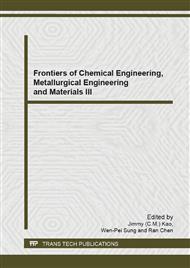[1]
Hwang, Y.S., Cho, J., Tay, F., et al. The use of murine embryonic stem cells, alginate encapsulation, and rotary microgravity bioreactor in bone tissue engineering. Biomaterials, 30(2009), 499-507.
DOI: 10.1016/j.biomaterials.2008.07.028
Google Scholar
[2]
Song, K., Liu, T., Cui, Z., et al. 3D Fabrication of Engineered Bone with Human Bio-derived Bone Scaffolds in a Rotating Wall Vessel Bioreactor. J Biomed Mater Res, 86A(2008), 323–332.
DOI: 10.1002/jbm.a.31624
Google Scholar
[3]
Bian, L., Zhai, D.Y., Tous, E., et al. Enhanced MSC chondrogenesis following delivery of TGF-β from alginate microspheres within hyaluronic acid hydrogels in vitro and in vivo. Biomaterials, 32(2011), 6425-34.
DOI: 10.1016/j.biomaterials.2011.05.033
Google Scholar
[4]
Liu, S., Zhang, H., Zhang, X., et al. Synergistic Angiogenesis Promoting Effects of Extracellular Matrix Scaffolds and Adipose-Derived Stem Cells During Wound Repair. Tissue Eng Part A, 17(2011), 725-39.
DOI: 10.1089/ten.tea.2010.0331
Google Scholar
[5]
Song, K., Qiao, M., Liu, T., et al. Preparation, fabrication and biocompatibility of novel injectable temperature- sensitive chitosan/glycerophosphate/collagen hydrogels. J Mater Sci Mater Med. 21(2010), 2835-2842.
DOI: 10.1007/s10856-010-4131-4
Google Scholar
[6]
Mazzitelli, S., Luca, G., Mancuso, F., et al. Production and characterization of engineered alginate-based microparticles containing ECM powder for cell/tissue engineering applications. Acta Biomaterialia, 7(2011), 1050-62.
DOI: 10.1016/j.actbio.2010.10.005
Google Scholar
[7]
Yu, J., Du, K.T., Fang, Q., et al. The use of human mesenchymal stem cells encapsulated in RGD modified alginate microspheres in the repair of myocardial infarction in the rat. Biomaterials, 31(2010), 7012-20.
DOI: 10.1016/j.biomaterials.2010.05.078
Google Scholar
[8]
Jiang, W.B., Shi, J., Wei, L., et al. Preparation and characterization of poly(E-caprolactone)-Natural bone powder composites for biomedical applications. Journal of Functional Polymers, 25(2012), 12-15.
Google Scholar
[9]
Song, K., Liu, Y., Wang, H., et al. Ex Vivo Expansion of Human Umbilical Cord Blood Hematopoietic Stem/Progenitor Cells with Support of Microencapsulated Rabbit Mesenchymal Stem Cells in a Rotating Bioreactor. Tiss Eng & Reg Med, 8(2011), 334-345.
DOI: 10.1080/02652040802193014
Google Scholar
[10]
Song, K., Wang, H., Zhang, B., et al. Numerical simulation of fluid field and in vitro three-dimensional fabrication of tissue-engineered bones in a rotating bioreactor and in vivo implantation for repairing segmental bone defects. Cell Stress Chaperone, 18(2013).
DOI: 10.1007/s12192-012-0370-2
Google Scholar
[11]
Song, K., Yang, Y., Li, S., et al. In vitro culture and oxygen consumption of NSCs in size-controlled neurospheres of Ca-alginate/gelatin microbead. Mat Sci Eng C-Mater, 40(2014), 197-203.
DOI: 10.1016/j.msec.2014.03.028
Google Scholar
[12]
Song, K., Liu, Y., Macedo, H.M., et al. Fabrication and Evaluation of a Sustained-Release Chitosan-based Scaffold Embedded with PLGA microspheres. Mat Sci Eng C-Mater, 33(2013), 1506-13.
DOI: 10.1016/j.msec.2012.12.054
Google Scholar
[13]
Song, K., Li, W., Wang, H., et al. Investigation of coculture of human adipose-derived stem cells and mature adipocytes. Appl Biochem Biotechnol. 167(2012), 2381-87.
DOI: 10.1007/s12010-012-9764-y
Google Scholar
[14]
Song, K., Wang, H., Wang, H., et al. Investigation of the Effective Action Distance between Hematopoietic Stem/Progenitor Cells and Human Adipose-Derived Stem Cells during Their In Vitro Co-culture. Appl Biochem Biotechnol, 165(2011), 776-84.
DOI: 10.1007/s12010-011-9295-y
Google Scholar


